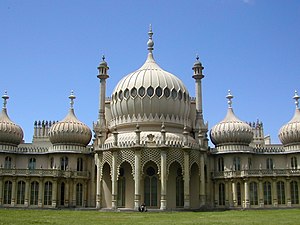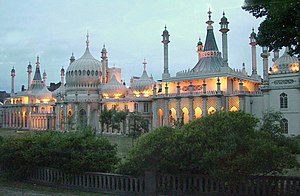Royal Pavilion
50°49′23″N 0°08′15″W / 50.82306°N 0.13750°W



The Royal Pavilion is a former royal residence located in Brighton, England. It was built in the early 19th Century as a seaside retreat for the then Prince Regent. It is often referred to as the Brighton Pavilion. It is built in the Indo-Saracenic style prevalent in India for most of the 19th century.
History
The Prince Regent, who later became King George IV, first visited Brighton in the year of 1783, due to his physician advising him that the seawater would be beneficial to his gout. In 1786 he rented a farmhouse in the Old Steine area of Brighton. Being remote from the Royal Court in London, the Pavilion was also a discreet location for the Prince to enjoy liaisons with his long-time companion, Mrs Fitzherbert. The Prince had wished to marry her, and may have done so secretly; however this was illegal due to her Catholic religion.
Henry Holland was soon employed to enlarge the building. The Prince also purchased land surrounding the property, on which was built in 1803 a grand riding school and stables in an Indian style, to designs by William Porden.
Between 1815 and 1822 the designer John Nash redesigned the palace, and it is the work of Nash which can be seen today. The palace looks rather striking in the middle of Brighton, having a very Indian appearance on the outside. However, the fanciful interior design, primarily by Frederick Crace and Robert Jones firm, is heavily influenced by both Chinese and Indian fashion (with Moghul and Islamic architectural elements). It is a prime example of the exoticism that was an alternative to more classicising mainstream taste in the Regency style.
Purchase by Brighton
After the death of George IV in 1830, his successor King William IV also stayed in the Pavilion on his visits to Brighton. However after Queen Victoria's last visit to Brighton in 1845, the Government planned to sell the building and grounds. However the Brighton Commissioners and the Brighton Vestry successfully petitioned the government to sell the Pavilion to the town for £53,000 in 1850 under the Brighton Improvement (Purchase of the Royal Pavilion and Grounds) Act 1850.[1]
Later use
During the First World War the Pavilion was used as a hospital for wounded Indian and West Indian servicemen. Dead Sikh and Hindu Indian soldiers were cremated on the Downs to the north of Brighton, where a Pavilion style memorial was constructed in their memory (map).
The Pavilion is open to visitors and is also made available for education purposes, banqueting, and weddings. The admission fee is reduced for local residents in the winter.
